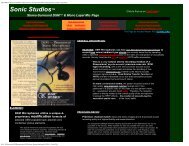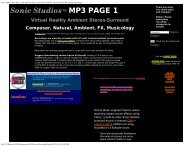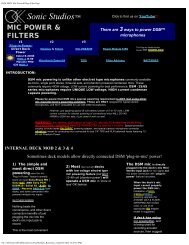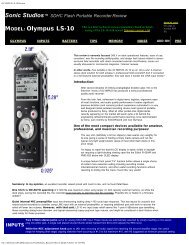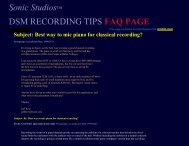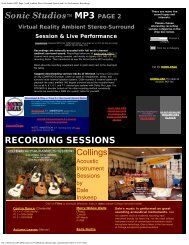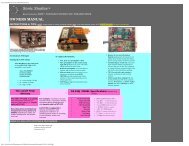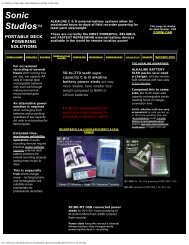Downloadable - Sonic Studios
Downloadable - Sonic Studios
Downloadable - Sonic Studios
Create successful ePaper yourself
Turn your PDF publications into a flip-book with our unique Google optimized e-Paper software.
absorptive baffle device (our head). This creates an interference acoustic pressure field pattern (analogy like shadow, moire, and<br />
rainbow effects all at the same time) that our brain translates into directional and dimensional information.<br />
This is the workings of psycho-acoustics where extremely complex holographical type information is 1st sensed and then processed by<br />
our genetically trained brain. A little more about this at: http://www.sonicstudios.com/multitrk.htm<br />
We don't as yet have computational ability and skills to do this kind of processing in real time and our HRTF working models are<br />
mostly too simplified for consistent synthesis in making or decoding this kind of information especially for multiple sources common in<br />
real ambient environments.<br />
Because we hear sounds in a general manner because of genetics, we actually want to hear recorded sounds mic'd in a similar 'preprocessed<br />
manner.' Unfortunately, we now automatically make big concessions with hearing any kind of recorded material because of<br />
the way the industry has NOT progressed to better understanding of recording methods for virtual reality purposes. Can't really<br />
blame them, keeping everybody beating around the techno 'proverbial' bush sells lots of shoes and cold drinks.<br />
Anyway, now you got me going! Let me know if I actually answered your question Richard.<br />
Cardioids are really useful for MONO multi-track with side -rear rejection ability that reduces vocal to PA & stage monitor feedback<br />
and reduces interferring adjacent multitracked instrument sounds when close mic'ing methods are used on stage and for studio session<br />
work. They are mostly problem solving microphones that greatly sacrifice acoustic fidelity to avoid potential off<br />
axis problems. Using them for stereo purposes has never worked very well; mostly very inconsistant in how schemes using such mics<br />
record a situation in stereo.<br />
For recording live events where acoustic quality or fidelity and a true feeling of 'being there' is important, you really don't want to use<br />
anything but a HRTF baffled omni microphone type system.<br />
Regards in Sound & Music Recording, Leonard Lombardo<br />
Subject: Re: Concert Recording >From: Kirby A@my-deja.com> >Date: Sat, 13 Jan 2001 02:25:09 GMT<br />
> >I have no doubt that everything you say is true, but the mics and baffle you suggest would be way too expensive. I may have to go<br />
with a different mic (non-cardioid), but can't afford the omnis. > >Kirby<br />
The most costly element for baffled omni mic system is the HRTF baffle. Replicating the acoustic response of water saturated tissue is<br />
no easy accomplishment and the raw material costs for the LiteGUY are impressive.<br />
However, there is a far less costly way that may be suitable for this your present project. Usually, using a baffle is a must when<br />
working close proximity to noisy and talkative crowds common at popular music venues these days. You need to get at least 8- 10 feet<br />
up and away from this crowd noise to get a good overall ambient mix.<br />
In your situation, the audience may be more respectful and allow someone seated (or standing) to record just as good an ambient<br />
sound from somewhere within the close stage to half back into the hall. This person would know how use the Sharp MD deck and<br />
personally headwear the mics (this is a real HRTF baffle).<br />
Head position should be facing stage forward with no looking left-right head turns, at least while recording; up-down head-mic



